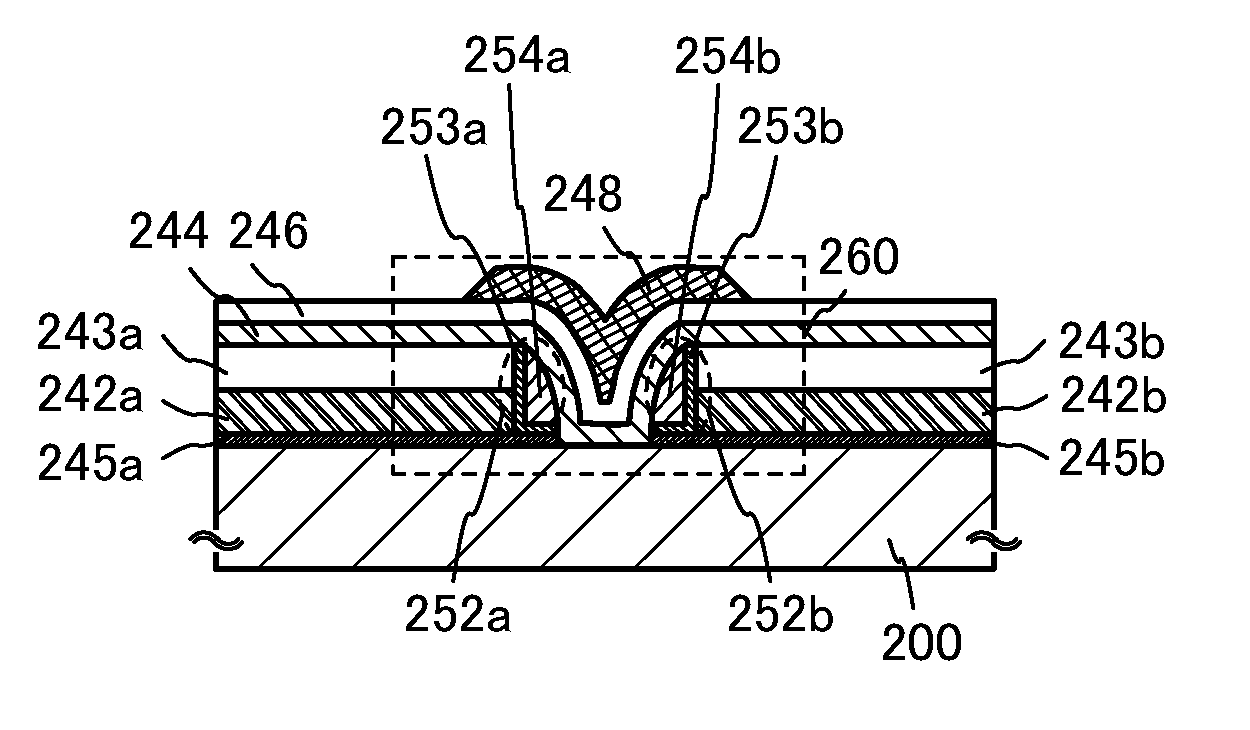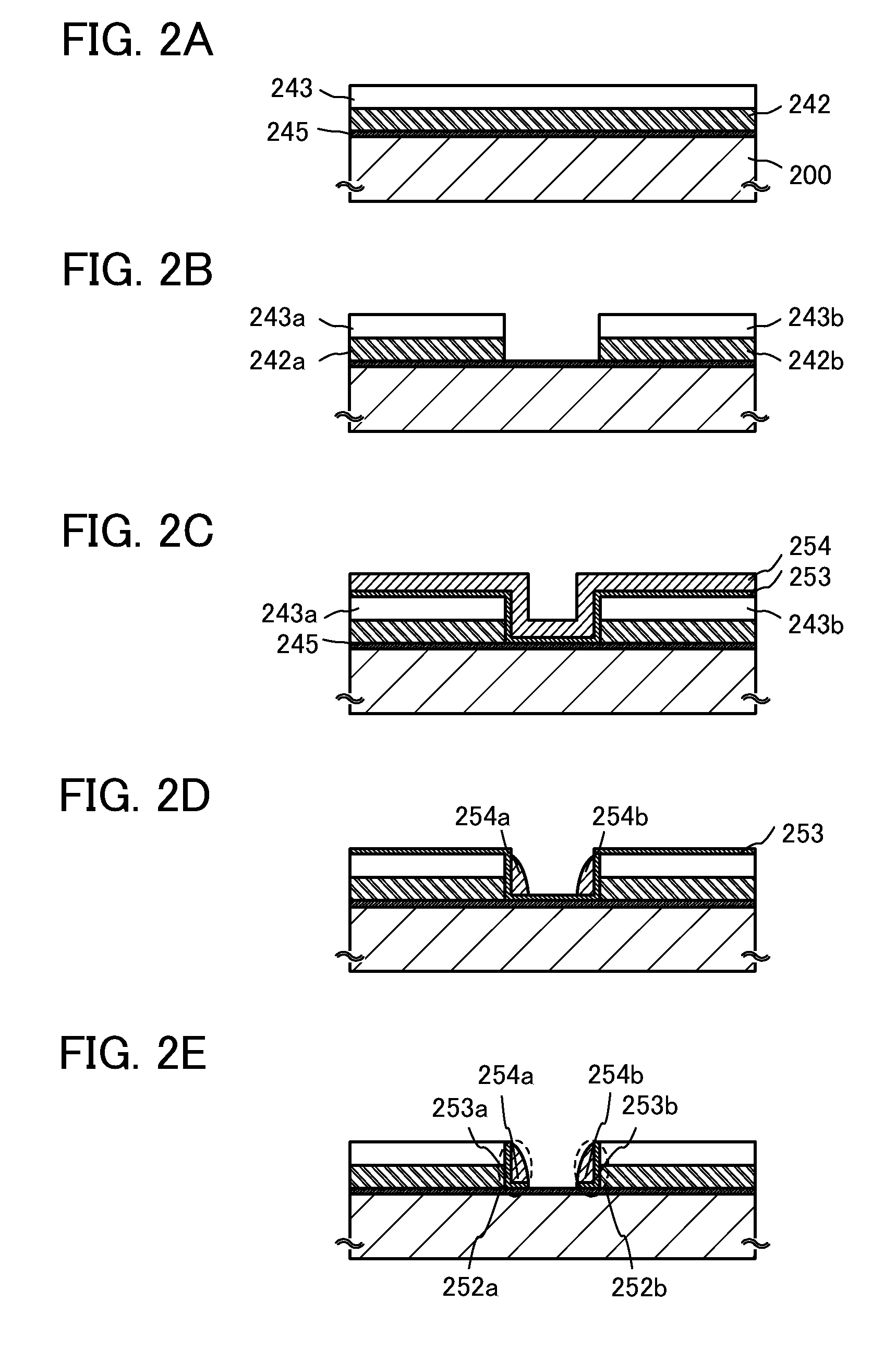Semiconductor device
a semiconductor and device technology, applied in semiconductor devices, instruments, electrical equipment, etc., can solve problems such as connection failure, short-channel effect problems, and serious problems generated in the manufacturing process, so as to reduce the variation in the electrical characteristics of transistors across the substrate plane, reduce the thickness of the second conductive layer, and reduce the contact area
- Summary
- Abstract
- Description
- Claims
- Application Information
AI Technical Summary
Benefits of technology
Problems solved by technology
Method used
Image
Examples
embodiment 1
[0048]In this embodiment, an example of a structure of a semiconductor device and a manufacturing process according to one embodiment of the disclosed invention will be described with reference to FIG. 1, FIGS. 2A to 2D, FIGS. 3A to 3D, and FIGS. 4A to 4C.
[0049]FIG. 1 illustrates a cross-sectional structure of a transistor as an example of a semiconductor device. FIG. 1 illustrates a top-gate transistor as a transistor according to one embodiment of the disclosed invention.
[0050]A transistor 260 illustrated in FIG. 1 includes, over a substrate 200, a source electrode in which a second conductive layer 245a and a first conductive layer 242a are sequentially stacked, a drain electrode in which a second conductive layer 245b and a first conductive layer 242b are sequentially stacked, a sidewall insulating layer 252a in contact with the source electrode, a sidewall insulating layer 252b in contact with the drain electrode, an insulating layer 243a over the source electrode, an insulatin...
modification example
[0115]Next, modified examples of the semiconductor device illustrated in FIG. 1 will be described with reference toFIGS. 4A to 4C.
[0116]A transistor 270 illustrated in FIG. 4A has a structure partly different from the structure of the transistor 260 illustrated in FIG. 1.
[0117]The transistor 270 illustrated in FIG. 4A has a sidewall insulating layer 252c and a sidewall insulating layer 252d. The sidewall insulating layer 252c includes an insulating layer 254c the length of a bottom surface of which in the channel length direction is shorter than the length (LS1) of an extended region of the insulating layer 253a. The sidewall insulating layer 252d includes an insulating layer 254d the length of a bottom surface of which in the channel length direction is shorter than the length (LD1) of an extended region of the insulating layer 253b.
[0118]A manufacturing method of the transistor 270 illustrated in FIG. 4A is described. After the steps illustrated in FIGS. 2A to 2E and FIG. 3A are ...
embodiment 2
[0129]In this embodiment, application examples of a semiconductor device according to one embodiment of the disclosed invention will be described with reference to FIGS. 5A to 5C. Here, an example of a memory device will be described. Note that in each of the circuit diagrams, “OS” may be written beside a transistor in order to indicate that the transistor includes an oxide semiconductor.
[0130]In the semiconductor device in FIG. 5A, a first wiring (a 1st line) and a source electrode of a transistor 300 are electrically connected to each other, and a second wiring (a 2nd line) and a drain electrode of the transistor 300 are electrically connected to each other. In addition, a gate electrode of the transistor 300 and one of a source electrode and a drain electrode of a transistor 310 are electrically connected to one electrode of a capacitor 320, a third wiring (a 3rd line) and the other of the source electrode and the drain electrode of the transistor 310 are electrically connected t...
PUM
 Login to View More
Login to View More Abstract
Description
Claims
Application Information
 Login to View More
Login to View More - R&D
- Intellectual Property
- Life Sciences
- Materials
- Tech Scout
- Unparalleled Data Quality
- Higher Quality Content
- 60% Fewer Hallucinations
Browse by: Latest US Patents, China's latest patents, Technical Efficacy Thesaurus, Application Domain, Technology Topic, Popular Technical Reports.
© 2025 PatSnap. All rights reserved.Legal|Privacy policy|Modern Slavery Act Transparency Statement|Sitemap|About US| Contact US: help@patsnap.com



